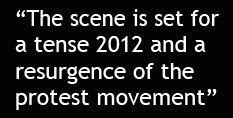[sharethis]
Last May, as the campaign for Spain’s local elections got underway, it looked like business as usual. Neither of the two main political parties was managing to inspire voters with hope or ideas as the country’s jobless line grew and the economic crisis deepened.
But on May 15, the Sunday before the elections, a group of well-organised, mainly young, activists gathered in Madrid and marched to the central square of Puerta del Sol. They set up a makeshift campsite, declared the Spanish political system unrepresentative and obsolete, and within days their support had snowballed across the country and the eyes of the world were on them.
Six months on, los indignados, or the 15-M movement, are no longer occupying Puerta del Sol and squares across Spain. But they are still active, and, arguably, have already created a legacy.
Neighbourhood assemblies have sprung up in towns and cities all over the country, in the name of direct democracy. Some are constructive, others are farcical, but these informal gatherings have given many Spaniards a voice they felt they lacked under their elected politicians.
Another repercussion has been to provide a boost to those seeking to stop the forced evictions of Spaniards unable to pay their mortgages, as the indignados have thrown their weight behind the anti-repossessions movement.
But arguably their most resonant influence has been on the global protest movement. Occupy Wall Street in the United States, the St. Paul’s Cathedral protesters in London and many others have taken up the indignados template: peaceful, campsite sit-ins with a horizontal structure and constant, painstaking consultation and voting.
The indignados, like their counterparts elsewhere, have faced accusations that they lack focus and political substance. At times, this has been a fair charge, with their manifesto becoming too far-reaching and foggy. But Spain’s protesters seem to enjoy relatively broad support from a society that shares their main complaints: a vice-like political duopoly that excludes smaller parties; rampant corruption; and an unaccountable, aloof political class that seems both impotent and lacking in ideas when faced with the economic crisis. The phrase “¡estoy indignado!” (“I’m outraged!”) has become a commonly used expression of Spaniards’ exasperation at the state of their country.
The indignados’ refusal to appoint official leaders makes it hard to put a face to the movement. Jon Aguirre Such, a young activist, was one of the most visible figures of the movement, but there were older figureheads too, such as the pensioner Francisco Román, who gave a rousing address via megaphone to protesters outside Congress.
 A series of marches and protests followed the dismantling of the indignados’ main camp in Madrid in June, suggesting they would be a major force in the lead-up to the November general election. Yet surprisingly, during the campaign itself they failed to match the impact of their springtime uprising, leading to questions about their future.
A series of marches and protests followed the dismantling of the indignados’ main camp in Madrid in June, suggesting they would be a major force in the lead-up to the November general election. Yet surprisingly, during the campaign itself they failed to match the impact of their springtime uprising, leading to questions about their future.
But with a Popular Party government coming to power, apparently committed to severe public spending cuts and a conservative social agenda, the scene is set for a tense 2012 and a possible resurgence of the protest movement. With the Socialists in disarray and the unions discredited, the indignados could be a major headache for the new administration.
This has been a year of protests: around the world, streets have been filled with people outraged at political and financial elites. Spain’s indignados may not have overthrown a totalitarian regime or destroyed an economic system, but they, more than anyone on the Iberian Peninsula, have epitomised the spirit of 2011.
Leave a Reply
You must be logged in to post a comment.